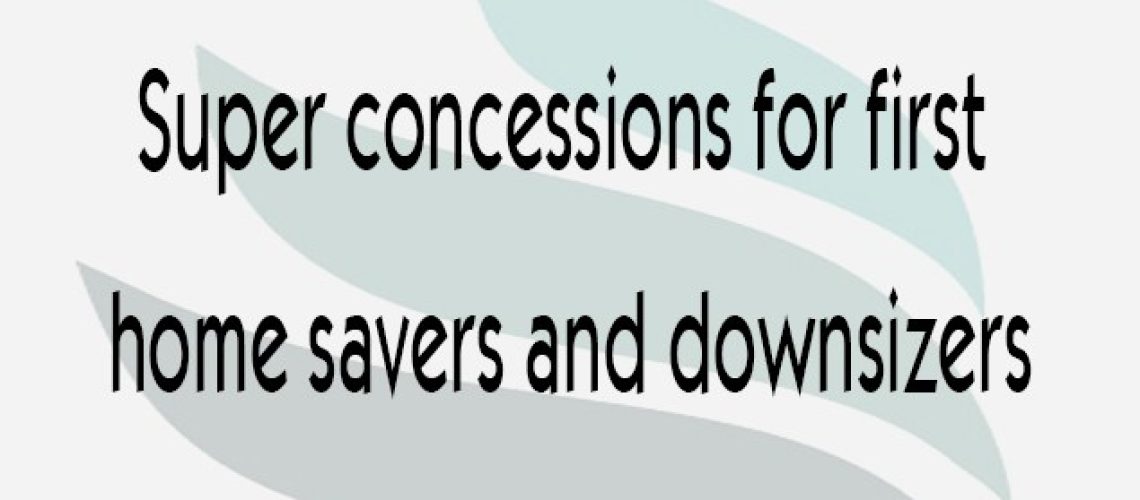Does superannuation offer an avenue to help downsizers and first home savers? The Government seems to think so. Late last month the detail of the housing initiatives announced in the Federal Budget were released for consultation. We explore what’s on offer and the implications.
Super concessions for downsizers
If you are over 65, have held your home for 10 years or more and are looking to sell, from 1 July 2018 you might be able to contribute some of the proceeds of the sale of your home to superannuation.

The benefit of this measure is that you can contribute a lump sum of up to $300,000 per person to superannuation without being restricted by the existing non-concessional contribution caps – $100,000 subject to your total superannuation balance – or age restrictions. It’s a way of building your superannuation quickly and taking advantage of superannuation’s concessional tax rates. The $1.6 million transfer balance cap will continue to apply so your pension interests cannot exceed this amount. And, the Age Pension means test will continue to apply. If you are considering using this initiative, it will be important to get advice to ensure that you are eligible to use this measure and the contribution does not adversely affect your overall financial position.
The downsizer initiative applies to the sale of any dwelling in Australia – other than a caravan, houseboat or mobile home – that you or your spouse have held continuously for at least 10 years. Over those 10 years, the dwelling had to have been your main residence for at least part of the time. As long as you qualify for at least a partial main residence exemption (or you would qualify for the exemption if a capital gain arose) you may be able to access the downsizer concession. This means that you do not actually need to have lived in the property for the 10 year period being tested.
The rules also take into account changes of ownership between two spouses over the 10 year period prior to the sale. This could assist in situations where a spouse who owned the property has died and their interest is inherited by their surviving spouse. The surviving spouse can count the ownership period of their deceased spouse in determining whether the 10 year ownership period test is satisfied. This rule could also assist in situations where assets have been transferred as a result of marriage or de facto relationship breakdown.
In general, the maximum downsizer contribution is $300,000 per contributor (so, $600,000 for a couple) but must only come from the proceeds of the sale. The contribution/s need to be made within 90 days after your home changes ownership (generally, the date of settlement) but you can apply to the Tax Commissioner to extend this period. And, the initiative only applies once – you cannot use it again for future properties.
Using super to save for your first home
Saving for a first home is hard. From 1 July 2018, the first home savers scheme will enable first-home buyers to save for a deposit inside their superannuation account, attracting the tax incentives and some of the earnings benefits of superannuation.
Home savers can make voluntary concessional contributions (for example by salary sacrificing) or non-concessional contributions (voluntary after tax contributions) of $15,000 a year within existing caps, up to a total of $30,000.
When you are ready to buy a house, you can withdraw those contributions along with any deemed earnings in order to help fund a deposit on your first home. To extract the money from super, home savers apply to the Commissioner of Taxation for a first home super saver determination. The Commissioner then determines the maximum amount that can be released from the super fund. When the amount is released from super, it is taxed at your marginal tax rate less a 30% offset.
For example, if you earn $70,000 a year and make salary sacrifice contributions of $10,000 per year, after 3 years of saving, approximately $25,892 will be available for a deposit under the First Home Super Saver Scheme – $6,210 more than if the saving had occurred in a standard deposit account (you can estimate the impact of the scheme on you using the estimator).
If you don’t end up entering into a contract to purchase or construct a home within 12 months of withdrawing the deposit from superannuation, you can recontribute the amount to super, or pay an additional tax to unwind the concessional tax treatment that applied on the release of the money.
To access the scheme, home savers must be 18 years of age or older, and cannot ever have held taxable Australian real property (this includes residential, investment, and commercial property assets). Home savers also need to move into the property as soon as practicable and occupy it for at least 6 of the first 12 months that it is practicable to do so.
As with the concession for downsizers, the first home saver scheme can only be used once by you.
While the capacity to voluntarily contribute to the first home savers scheme started on 1 July 2017 (with withdrawals available form 1 July 2018), it’s best to wait until the legislation is confirmed by Parliament just in case anything changes.

